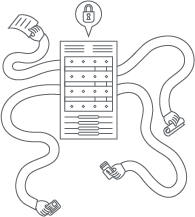5 reasons why you shouldn’t leave tax planning until June...
We have compiled a list of 5 reasons why you shouldn't avoid tax planning for your building and trade business.
With the current building boom and changes to the asset write off rules, it is more important than ever to plan ahead (and early) for your taxes.
1. Asset Protection & Tax Savings for business owners
Many building and trade businesses have found themselves with more assets, more employees, and more profits this income year, however, without adequate planning, this could go to waste.
Tax planning earlier in the year allows for time to review and set up new business structures to protect your assets and potentially save tax.
Example: Mr Maker was running a growing cabinetry business as a sole trader. During the financial year, he spoke with his trusted accountant who provided him with details of different business structures and potential tax liabilities. As Mr Maker sought advice early, he was able to protect his personal assets and save tax by transferring his business into a Company that is owned by a Trust.
2. PAYG Instalments
The ATO may require instalments of tax to be made during the year, this will be based on your most recently lodged tax return.
There are many reasons why these instalments may not match your tax bill at the end of the year.
Tax planning will help to determine if:
- You are paying too much – we can lodge a variation to reduce the ATO instalment to keep the cash in your business.
- You are not paying enough – being aware of your upcoming tax bill will allow you to effectively manage your cashflow.
Example: Bob runs his business through the Builder Family Trust. In the previous year, the Trust was entitled to write off the Small Business Pool balance of $100,000. This led to significant tax savings. When Bob lodged his tax return, his current year PAYG instalments were reduced. By prioritising tax planning, it was determined that the instalments paid during the year would not be sufficient to cover the tax bill. Bob was then able to put the estimated tax aside, allowing him to make better cashflow decisions.
3. Key Dates That Can Impact Your Tax Liability
Did you know that the due date for claiming a superannuation tax deduction is the date that the payment is received by the superfund, not the date the cash leaves your account?
Your June quarterly superannuation must be received by the Superfund by 28 July to be tax deductible.
By tax planning, we can establish if you should be paying the superannuation a month earlier in June.
By planning early, you can ensure you have sufficient cashflow and receive the deduction in the most tax effective year.
Under the new Temporary Full Expensing rules, to claim a full deduction for purchases in 2022, the asset must be on hand or installed ready for use by 30 June 2022.
Due to supply issues, you may need to purchase your asset early to ensure that you meet these rules.
The deductions available under the Temporary Full Expensing rules can add up to a significant amount.
If these purchases are not managed appropriately, they may lead to additional tax being paid due to ineffective use of the tax brackets.
Example: Bob wanted to save tax, so he thought the Builder Family Trust should bring forward their equipment purchases into June 2022. Luckily, he decided to review his tax position before buying and found that due to the Builder family’s tax position, the best way to save tax in 2022 and 2023 was to spread out the purchases across these years.
4. Buying Assets Just to Get a Tax Deduction
Just because an item can get a tax deduction doesn’t mean you should buy it, regardless of the store’s advertising.
You need to determine if this item will help your business, or could the cash be better used for something else?
Example: Assuming your marginal tax rate is 39%, every $1,000 you spend on a deductible purchase will leave you $610 out of pocket.
5. Achieve Goals & Manage Cash Flow
It is easy in a boom time to be too busy working to stop and reflect on your business plan BUT it’s often the most important time to do so.
Having regular reviews of your business is crucial to achieving long term success.
It will help you to set and monitor your goals to ensure that you are able to seize new opportunities and make the most of this time.
Tax planning is much more than just estimating your tax bill or planning for tax benefits, its about preparing your small business entity for the future.
If you would like assistance in growing your business, please reach out to your local RSM office.


